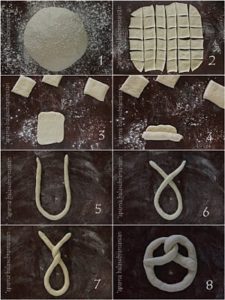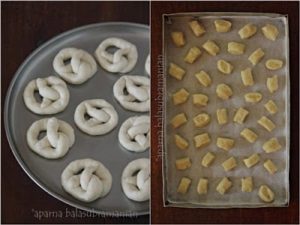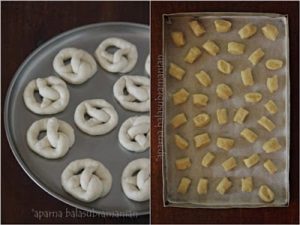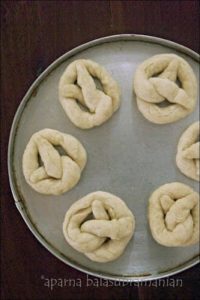
I’m always looking for interesting or unusual breads to bake, and this time the We Knead To Bake group is baking Pretzels. Having baked Soft Pretzels/ Laugenbrezhen before, I chose to try my hand the crisper and crunchier version of Pretzels. We all had the option of choosing to bake either soft ones or the crunchier ones, and most of the bread bakers in the group chose to bake Laughenbrezel, the softer ones
What’s really interesting about the Pretzel, whether hard or soft, is that it gets cooked twice. First the Pretzel dough is shaped and boiled in a soda bath and then baked in the oven till it turns a beautiful brown.
Traditionally, Pretzels were boiled in a lye bath (sodium hydroxide and water) which is what causes the browning and the distinctive taste, but working with lye is dangerous and requires safety precautions like wearing goggles and rubber gloves to prevent contact with the solution!
That’s a scary thought and a soda bath (2 tablespoon baking soda for 6 cups of water) is less dangerous, easier to work with and produces much the same result. An added bonus is that after the Pretzels have been boiled, the hot solution is a good drain cleaner if poured down your kitchen sink!

Pretzels are usually topped with flaked or coarse salt, but sesame seeds and poppy seeds are also used. The ideal German Pretzel has a dark brown, crispy, salty crust, and a soft bready interior. The top of the Pretzel (where the “arms” cross/ twist) is thinner while the bottom is usually plump.
Hard pretzels are not German but an American creation. The Laugenbrezel is supposedly Bavarian in origin and thought to have been created by accident.
Apparently, one morning sometime in the early 1800s, one Anton Pfanenbrenner who was a baker at the Munich Royal Café, was making sweet Pretzels. Instead of using a sugar solution to brush the dough, he accidentally brushed them with a sodium hydroxide solution used to clean and disinfect the bakery countertops! He decided to bake the pretzels anyway.
The Pretzels came out of the oven with a lovely brown crust and delighted his customers. I hate to think what would have happened if ended up poisoning his customers and killing them instead! One does not expect kitchen cleaners and disinfectants to be edible…

As for the reason why Pretzels are shaped the way they are, there are a few theories. Some say the shape comes from the Roman ring-bread which was a small, circular-shaped bread, while others believe that Pretzels were shaped to resemble a praying monk (back then the praying position was arms crossed with the hands on the shoulders)
All across Germany, Pretzels vary slightly in shape. In Bavaria, the arms of the Pretzel are shorter and attached closer to the top (thin part) of the pretzel and in Schwaben, the arms of the Pretzel sit very low on the body.
There are different types of German Pretzels like the Wiesnzeit/Oktoberfest Pretzel (made for the Munich Oktoberfest – larger, not so brown and more like bread), Neujahrsbrezel/ New Year Pretzels made in Baden and Schwaben (with milk dough or sweet yeasted dough and no boiling in lye bath), Nussbrezel/ Nut-Pretzel (sweet and made from flaky puff pastry), and the Fastenbrezeln/ Lent Pretzel (made during Lent, light coloured and boiled in water only before baking)

There are also other breads made in Germany using the same dough as Pretzel dough and the lye/ soda bath technique and these breads are collectively referred to as Laugengebäck. Some of these include Laugenstangen (Pretzel Bread Sticks), Laugenbrötchen (Pretzel Rolls), and the Käse-Brezel (Cheese Pretzel)
This recipe is for hard/ crunchy pretzels and the dough can be shaped to make Pretzel Bites, Sticks or the regular shaped Pretzels. The pretzels will be rather crunchy on the outside with a slightly bready middle. The important thing here is to make sure the dough is rolled out quite thin if you want them really crunchy. Serve them with dipping sauces for an enjoyable snack.
If you should like the idea of the shape of the Pretzel but don’t want the bother of dunking your dough in soda baths you could always try making this Cheese Onion Pretzel Bread. Of course, you wouldn’t find the distinctive taste of the Pretzel in this one, but its a pretty good bread!
Pretzels are not too difficult to make and it’s probably the shaping that will take your time, unless you are already quite good at it. These videos on shaping Pretzels and making them are quite self-explanatory and will be a great help if this is your first attempt at making them. You will find that my Pretzels look rather plain and a bit dull. That’s because I didn’t have coarse salt to sprinkle on them, and I didn’t use an egg wash on my Pretzels.
Crunchy/ Hard Pretzels.
(Adapted from Alton Brown’s recipe)

We Knead To Bake #8: Crunchy Hard Pretzels With Spicy Garlic & Herb Cheese Sauce & Honey-Mustard Dipping Sauce
Ingredients
- 1 3/4 cups water warm (about 40C or 110F)
- 1 tablespoon sugar
- 2 tsps active dry yeast
- 4 1/2 cups all-purpose flour (a little more if necessary)
- 2 tsps salt *
- 6 cups water
- 2 tbsps baking soda
- optional Egg wash (1 yolk + 2 tbsp water whisked together) -
- Pretzel salt or coarse salt crystals
Instructions
- You can knead by hand but it is easier with a machine. As always, I used the food processor. Put the warm ware, sugar and yeast in a bowl and mix. Keep aside for about 5 minutes or so until the yeast activates and becomes u201cfrothyu201d.
- Put this, the flour and the salt in the processor bowl and knead until you have a soft, smooth and elastic dough that is slightly sticky to touch, but pulls away from the sides of the bowl. If your dough feels too wet add a couple of tablespoons of flour to get the required consistency.
- Shape the dough into a ball and pace it in an oiled bowl, turning it to coat it well. Cover and let it double in volume. This should take about an hour or so.
- Deflate the dough, so that almost all the air is removed. Lightly flour your work surface and roll the dough out into a 12u201d by 12u201d square. Then using a pizza cutter divide the square into 36 smaller equal sized squares by cutting into six 2u201d wide strips both vertically and horizontally. The purpose of this exercise is to get 36 equal sized bits of dough!
- Now lightly oil your palms and your work surface. If you add too much of oil you will not be able to roll out the dough into u201cropesu201d. Flatten each square of dough and then roll it up as tightly as you can. Now place the u201crolledu201d bit of dough on your work surface and using your hands, roll it out into a uniform u201cropeu201d of about 15u201d length. It will be thinner than a pencil.

- You can leave them as u201csticksu201d instead of shaping them into pretzels. If you want them shorter, you can halve them. Remember baking time will differ depending on the shape of your pretzels. The baking temperature is the same whether you shape them into sticks or pretzels.
- If you would prefer to make pretzel bites then do not roll the dough out into a square. Just divide it into 4 portions and then roll each portion into a u201crope that is about 1u201d in diameter. Cut each rope into 1 1/2" bits. Roll each ball into a long rope about 1u201d in diameter. Cut each rope into 1 1/2" bits. Then proceed to boil them as given in the instructions below. Bake the pretzel bites at 210C (425F) for about 15 minutes.

- Shape it into a pretzel and place it on a greased plate or sheet. Working as quickly as you can, repeat with as many pieces of dough that you can bake as one batch while keeping the other bits of dough covered with a damp towel to prevent them from drying out. It is better to work in batches to get better results. Place the shaped dough on the greased plate/ sheet leaving about 1/2" space between them.
- First prepare your baking sheets. It is a good idea to line them with parchment paper which is lightly brushed with oil. This makes them easy to remove after baking and also protects your baking sheets from the soda solution.
- Now prepare the soda bath. Bring 6 cups of water to boil in a deep pan/ pot. Add the baking soda carefully. It will bubble up and froth a bit and then settle down. Using a slotted spoon or a spatula, gently slide about 5 to 6 pretzels, one at a time, into the bath. Let them cook on one side for 10 seconds. Flip them over and cook them for another 10 seconds. Do not cook them for more than 30 seconds in total, or your dough will become slimy.

- Shape it into a pretzel and place it on a greased plate or sheet. Working as quickly as you can, repeat with as many pieces of dough that you can bake as one batch while keeping the other bits of dough covered with a damp towel to prevent them from drying out. It is better to work in batches to get better results. Place the shaped dough on the greased plate/ sheet leaving about 1/2" space between them.
- First prepare your baking sheets. It is a good idea to line them with parchment paper which is lightly brushed with oil. This makes them easy to remove after baking and also protects your baking sheets from the soda solution.
- Now prepare the soda bath. Bring 6 cups of water to boil in a deep pan/ pot. Add the baking soda carefully. It will bubble up and froth a bit and then settle down. Using a slotted spoon or a spatula, gently slide about 5 to 6 pretzels, one at a time, into the bath. Let them cook on one side for 10 seconds. Flip them over and cook them for another 10 seconds. Do not cook them for more than 30 seconds in total, or your dough will become slimy.

- Remove the boiled pretzels with a slotted spoon and place them on the parchment lined baking sheets. If using the egg wash, brush it over the pretzels, and then sprinkle it with the salt.
- Bake them at 180C (335F) for 40 to 50 minutes until theyu2019re deep golden brown in colour and hard. Cool them on a rack and store them in airtight containers or they will become soft and chewy.
Notes



Leave a Reply